
Dan Feidt's log on Minnesota, Information Operations, spinstorms and latent contradictions.
Iraqi intuition: As Joe Biden and Chris Matthews talked about on Hardball the other night, apparently President Bush did not expect Iraqi Shiites to support Hezbollah. This is the shrewd leadership of the War on Terror, folks. Sy Hersh was talking about how Cheney's office spoofed the intelligence on Lebanon and Israel. Again, the rosy shock-and-awe type scenarios failed tactically and stategically, as they always do. Strategic bombing never really works.
Apparently, The Pentagon's Air Force types were convinced Israel's planned tactical air campaign (long planned) would work. According to Hersh and others, the Marines and the Army are very skeptical about attacking Iran, since they would get sent in to invade Iran when the Air Force plan fails. It turns out that the intuitions of the Pentagon skeptics were right, not surprisingly. Any kind of military action on Iran would make our whole Middle East situation completely fall apart – and yes, the Iranians have a lot of fancy missiles they've bought with all the oil money. Iran's mountainous terrain makes South Lebanon look like a golf course.
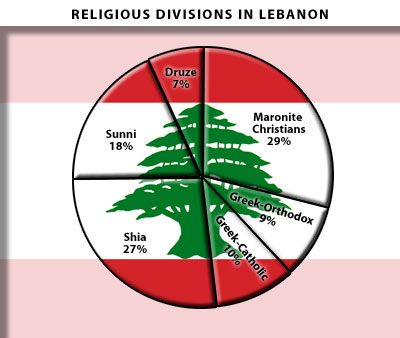 This image comes from former Defense Intelligence Agency officer Pat Lang's blog, Sic Semper Tyrannis, which has had some of the best commentary on the tactics between the IDF and Hezbollah.
This image comes from former Defense Intelligence Agency officer Pat Lang's blog, Sic Semper Tyrannis, which has had some of the best commentary on the tactics between the IDF and Hezbollah.
Various commentaries: "How I found myself with the Islamic fascists" by Jonathan Cook. This essay would make Bill O'Reilly's head explode. "Israel, Defeated: Round one: Lebanon, 1 – Israel, 0" by Justin Raimondo at AntiWar.com.
Huzzah for Shias: Check out the book review of The Shia Revival.
Hezbollah's suicide bombers in past campaigns were mostly not Shiite: this is fascinating because it indicates that 'religion' per se is not the motivating factor for suicide attacks. What is? Foreign military occupation. Evidence: Professor Robert Pape found this, posted in the Guardian: What we still don't understand about Hizbollah, August 6:
This week, world terrorism expert Robert Pape will share with the FBI the findings of his remarkable study of 462 suicide bombings. He concludes that such acts have little to do with religious extremism and that the West must engage politically to halt the relentless slaughter: Israel has finally conceded that air power alone will not defeat Hizbollah. Over the coming weeks, it will learn that ground power won't work either. The problem is not that the Israelis have insufficient military might, but that they misunderstand the nature of the enemy.
In terms of structure and hierarchy, it is less comparable with, say, a religious cult such as the Taliban than to the multi-dimensional American civil rights movement of the 1960s. What made its rise so rapid, and will make it impossible to defeat militarily, was not its international support but the fact that it evolved from a reorientation of pre-existing Lebanese social groups.
Evidence of the broad nature of Hizbollah's resistance to Israeli occupation can be seen in the identity of its suicide attackers. Hizbollah conducted a broad campaign of suicide bombings against American, French and Israeli targets from 1982 to 1986. Altogether, these attacks, which included the infamous bombing of the marine barracks in Beirut in 1983, involved 41 suicide terrorists. Researching my book, which covered all 462 suicide bombings around the globe, I had colleagues scour Lebanese sources to collect martyr videos, pictures and testimonials and biographies of the Hizbollah bombers. Of the 41, we identified the names, birth places and other personal data for 38. We were shocked to find that only eight were Islamic fundamentalists; 27 were from leftist political groups such as the Lebanese Communist Party and the Arab Socialist Union; three were Christians, including a female secondary school teacher with a college degree. All were born in Lebanon. What these suicide attackers - and their heirs today - shared was not a religious or political ideology but simply a commitment to resisting a foreign occupation. Nearly two decades of Israeli military presence did not root out Hizbollah. The only thing that has proven to end suicide attacks, in Lebanon and elsewhere, is withdrawal by the occupying force.
Previous analyses of suicide terrorism have not had the benefit of a complete survey of all suicide terrorist attacks worldwide. The lack of complete data, together with the fact that many such attacks, including all those against Americans, have been committed by Muslims, has led many in the US to assume that Islamic fundamentalism must be the underlying main cause. This, in turn, has fuelled a belief that anti-American terrorism can be stopped only by wholesale transformation of Muslim societies, which helped create public support of the invasion of Iraq. But study of the phenomenon of suicide terrorism shows that the presumed connection to Islamic fundamentalism is misleading.
There is not the close connection between suicide terrorism and Islamic fundamentalism that many people think. Rather, what nearly all suicide terrorist campaigns have in common is a specific secular and strategic goal: to compel democracies to withdraw military forces from territory that the terrorists consider to be their homeland. Religion is rarely the root cause, although it is often used as a tool by terrorist organisations in recruiting and in other efforts in service of the broader strategic objective. Most often, it is a response to foreign occupation.
Understanding that suicide terrorism is not a product of Islamic fundamentalism has important implications for how the US and its allies should conduct the war on terrorism. Spreading democracy across the Persian Gulf is not likely to be a panacea as long as foreign troops remain on the Arabian peninsula. The obvious solution might well be simply to abandon the region altogether. Isolationism, however, is not possible; America needs a new strategy that pursues its vital interest in oil but does not stimulate the rise of a new generation of suicide terrorists. The same is true of Israel now.....
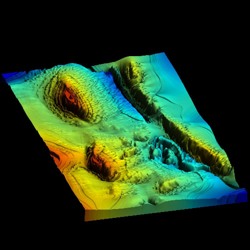 The backdrop is energy resources, and water too. From The Wilderness teased a pay story:
The backdrop is energy resources, and water too. From The Wilderness teased a pay story:
AS THE WORLD REELS FROM ISRAELI ATTACKS ON INNOCENT CIVILIANS DURING THE PAST THREE WEEKS, CULMINATING IN THIS WEEKEND'S ATROCITIES AT QANA, WE HEAR LITTLE ABOUT THE PIPELINE POLITICS AND WATER ISSUES BEHIND THE SCENES. BUT ISRAEL'S DESPERATE MILITARY MADNESS CANNOT BE FULLY UNDERSTOOD WITHOUT GRASPING THE FRANTIC RESOURCE WARS THAT FORM THE BACKDROP OF THE CURRENT MIDDLE EAST CARNAGE.
True enough. Encircling the Shiite's area of oilfields is important to guys like Dick Cheney. The situation in Iraq is fueled by the conflict over Iraq's oil revenue, of course. That crazy relief map is from here. It shows the Rumaila and other key oilfields around the Kuwaiti-Iraqi border. Rumaila was one of the key reasons Saddam invaded Kuwait. He claimed they were slant-drilling under the border, which was probably true since the Kuwaitis are dickheads.
Here is a map of the Sunni-Shiite distribution. In my opinion it actually doesn't show the Shiites of eastern Saudi Arabia correctly, but oh well... Shiites are darker.
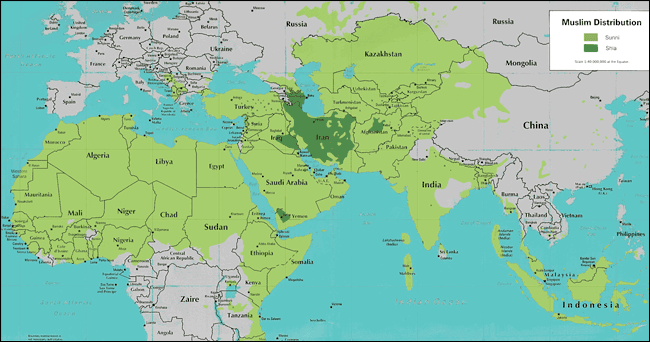
And here is the famous Iraq oil map (PDF) from Cheney's energy task force:
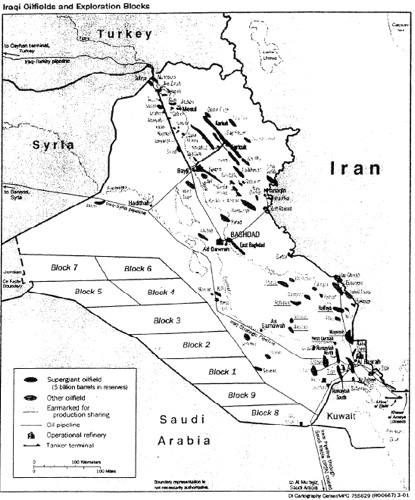
There is this kind of strategy to encircle the general area... The Christian Science Monitor had this badass map showing where American troops are, relative to the pipelines: (more on this here)

I don't know what the hell this is, some kind of "heat map", but it looks cool from a cool-looking site:

The Israelis are holding the Golan Heights because of water, as they tell you, and the West Bank wall is laid out to cut off many wells from Palestinian access. The largest settlement in the West Bank, Ariel, is situated on a ridge area in the north, directly above the main aquifer. One wonders why the Litani River is such a big deal anyway. More on Ariel.
I recommend reading this page about Israel's water wars. It's very relevant. For your comparison here, the 'nose' of the West Bank that juts just outside of the red mountain aquifer is Kalkilya - the northern West Bank's westernmost Palestinian city. Ariel, the most horizontal blob, is centered on the red aquifer, as you can see with the power of imagination (since the American media is never going to fucking tell you this).

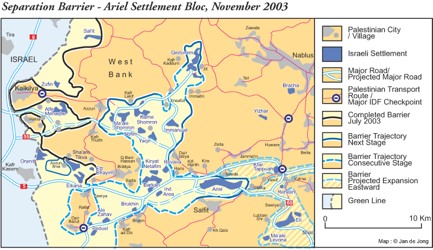
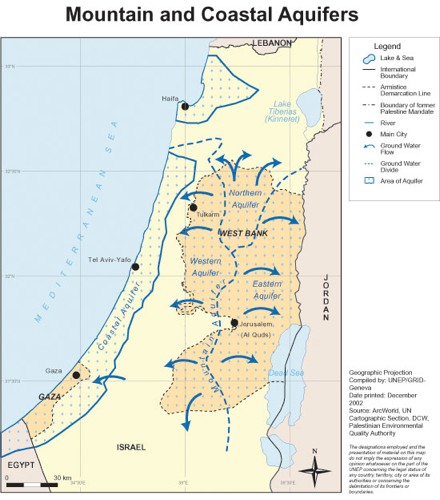
Iran noise: so we've gathered that this whole thing was an overture to a war in Iran (aka "World War III"). As one pretty pissed off international studies professor, Alon Ben-Meir put it:
The war of perception: Israel`s failure will undoubtedly embolden Iran to challenge it at a different time and circumstance, while Syria may decide that Israel is not such a formidable military after all and resort to more aggressive tactics to regain the Golan.
Hamas` resolve to resist Israel may harden, and Hezbollah which, by every objective military standard, suffered a strategic defeat, has already emerged as triumphant in the eyes of the Arab world for having withstood the Israeli onslaught with valor, may be emboldened to lie in wait for the next confrontation.
Having lost the war of perception Israel must be careful not to translate this into real strategic losses in dealing with the Arab-Israeli conflict or with Iran.
.......
The real danger in the future comes from Iran, and it looms extremely large. If it is to respond effectively, Israel must develop strategies that deny Iran not just the opportunity to meddle in the Arab-Israeli conflict but make Tehran fear for its very existence, and so refrain from even contemplating any act of hostility against Israel.
An Israel that is, rightly or wrongly, perceived as weak, will simply invite more serious military challenges because Israel`s real enemies like Iran are relentless, and now they smell blood.
That's all for now. I really like maps!
Now that the dust is settling, we are hearing reports from the field about what exactly Hezbollah was doing down in South Lebanon. For more military analyses look at this excellent thread on Agonist.org Lessons Learned. Guys like William Lind have good stuff too.
For the moment, we are going to post a big chunk of Anthony Cordesman's summary of the whole damn thing. The press conference is here (PDF), the actual doc is here.
Center for Strategic and International Studies
1800 K Street, N.W. • Suite 400 • Washington, DC 20006
Phone: 1 (202) 775-3270 • Fax: 1 (202) 457-8746
Web: http://www.csis.org/burke/
Preliminary “Lessons” of the Israeli-Hezbollah War (PDF)
Anthony H. Cordesman, Arleigh A. Burke Chair in Strategy acordesman@aol.com
Working Draft for Outside Comment, Revised: August 17, 2006
[Page 16]....
Lessons and Insights into Various Tactical,
Technological, and Other Military Aspects of the War
Once again, it is important to stress that many key details of the tactics, technology, and
other aspects of the fighting are not yet clear. There are, however, several additional
lessons that do seem to emerge from the conflict.
High Technology Asymmetric Warfare
There is virtually no controversy over whether the fighting with the Hezbollah shows just
how well a non-State actor can do when it achieves advanced arms, and has strong
outside support from state actors like Iran and Syria. Top-level Israeli intelligence
personnel and officers stated that most aspects of the Hezbollah build-up did not surprise
them in the six years following Israel’s withdrawal in Lebanon.
Mosad officials stated that they had tracked the deployment of some 13,000 Katyushas,
far more sophisticated Iranian medium and long-range artillery rockets and guided
missiles (Zelzal 3), better surface-to-air missiles like the SA-14, SA-16, and possibly SA-
8 and SA-18, the CS-801 anti-ship missile, and several more capable anti-tank weapons
like the AT-3 Sagger Two and Kornet. They also identified the armed UAV the
Hezbollah used as either the Iranian Mirsad-1 or Ababil-3 Swallow.
Israeli intelligence officials also stated that they knew some 100 Iranian advisors were
working with the Hezbollah, and that they knew Iran not only maintained high volumes
of deliveries, but also had created a Hezbollah command center for targeting and
controlling missile fire with advanced C2 assets and links to UAVs. They noted that they
had warnings of better sniper rifles, night vision devices, and communications as well as
of technical improvements to the IEDs, bombs, and booby traps that the Hezbollah had
used before the Israeli withdrawal.
Israeli officials and officers were not consistent about the scale or nature of the
technology transfer to the Hezbollah or of how many weapons they had. In broad terms,
however, they agreed on several points.
Hezbollah Rocket and Missile Forces
Israel faced a serious local threat from some 10,000-16,000 shorter-range regular and
extended range versions of the Kaytusha. These are small artillery rockets with individual
manportable launchers. The rockets have small warheads and ranges of 19-28 kilometers
(12-18 miles) that can only strike about 11-19 kilometers (7-12 miles) into Israel unless
launched right at the border. They can easily be fired in large numbers from virtually any
position or building, and the Hezbollah had a limited capacity for ripple fire that partly
made up for the fact that such weapons were so inaccurate that they hit at random, could
only be aimed at town-sized targets, and had very small warheads. They were, however,
more than adequate to force substantial evacuations, paralyze local economic activity,
and drive the Israelis that remained to shelters.
Israeli officers and officials made it clear that Israel’s real reason for going to war,
however, was the steady deployment of medium and longer range systems, and the
potential creation of a major Iranian and Syrian proxy missile force that could hit targets
throughout Israel.
This force included Syrian 220mm rockets and systems like the Fajr 3, with ranges of 45-
75 kilometers, capable of striking targets as far south as Haifa and Naharia. The IAF was
able to destroy most of the Iranian Fajr 3 launchers the first night of the war, but the IDF
did not know the Syrian rockets were present.
The Fajr 3, or Ra’ad, has a range of 45 kilometers, a 45-kilogram warhead, a 240-mm
diameter, a 5.2-meter length, and a weight of 408 kilograms.
A total of some 24-30 launchers and launch vehicles, carrying up to 14 rockets each, seem to have been present.
The IAF feels it destroyed virtually all launchers that fired after the first few days, but
Israeli officers did not provide an estimate of how many actually survived.
They also included the Syrian 302-mm artillery rockets and Fajr 5, with ranges of 75 and
higher kilometers. The IAF again feels that it was able to destroy most of the Iranian Fajr
5 launchers the first night of the war, but the IDF again did not know the Syrian 302-mm
rockets were present.
The Fajr 5 is launched from a mobile platform with up to four rockets per launcher, and
has a maximum range of 75 kilometers, a 45-kilogram warhead, a 333-mm diameter, a
6.48-meter length, and a weight of 915 kilograms.
A total of some 24-30 launchers and launch vehicles seem to have been present. Again, the IAF feels it destroyed virtually all
launchers that fired after the first few days, but Israeli officers did not provide an estimate
of how many actually survived.
The level of Hezbollah capabilities with the Zelzal 1, 2, and 3 and other possible systems
has been described earlier. These missiles have ranges of 115-220 kilometers. The Zelzal
2 is known to be in Hezbollah hands and illustrates the level of technology involved. It is
a derivative of the Russian FROG 7, and has a range in excess of 115 kilometers. It has a
610-mm diameter, a 8.46-meter length, and a weight of 3,545 kilograms.
It requires a large TEL vehicle with a large target signature.
Anti-Ship Missiles
The Hezbollah C-802 missile that damaged an Israeli Sa’ar 5, one of Israel’s latest and
most capable ships, struck the ship when it was not using active countermeasures. It may
or may not have had support from the coastal radar operated by Lebanese military fires
destroyed by IAF forces the following day.
According to Global Security, the Yingji YJ-2 (C-802) is powered by a turbojet with
paraffin-based fuel. It is subsonic (0.9 Mach), weighs 715 kilograms, has a range 120
kilometers, and a 165 kilogram (363 lb.). It has a small radar cross section and skims
about five to seven meters above the sea surface when it attacks the target. It has good
anti-jamming capability.
Anti-Armor Systems
The IDF faced both older anti-tank guided missile (ATGM) threats like the AT-3 Sagger,
AT-4 Spigot, and AT-5 Spandrel—each of which is a wire-guided system but which
become progressively more effective and easier to operate as the model number
increases.
The IDF also faced far more advanced weapons like the Russian AT-13 Metis-
M which only requires the operator to track the target, and the AT-14 Kornet-E, a third
generation system, that can be used to attack tanks fitted with explosive reactive armor,
and bunkers, buildings, and entrenched troops. Many of these systems bore serial
numbers that showed they came directly from Syria, but others may have come from Iran.
The AT-14 is a particularly good example of the kind of high technology weapon the US
may face in future asymmetric wars. It can be fitted to vehicles or used as a crew-portable
system.
It has thermal sights for night warfare and tracking heat signatures, and the
missile has semi-automatic command-to-line-of-sight laser beam-riding guidance. It flies
along the line of sight to engage the target head-on in a direct attack profile. It has a
nominal maximum range of 5 kilometers. It can be fitted with tandem shaped charge
HEAT warheads to defeat tanks fitted with reactive armor, or with high
explosive/incendiary warheads, for use against bunkers and fortifications. Maximum
penetration is claimed to be up to 1,200mm.
Other systems include a greatly improved version of the 105.2-mm rocket-propelled
grenade called the RPG-29 or Vampire. This is a much heavier system than most
previous designs. It is a two-man crew weapon with a 450-meter range, and with an
advanced 4.5-kilogram grenade that can be used to attack both armor and bunkers and
buildings. Some versions are equipped with night sights.
The IDF saw such weapons used with great tactical skill, and few technical errors,
reflecting the ease with which third generation ATGMs can be operated. They did serious
damage to buildings as well as armor. The Hezbollah also showed that it could use the
same “swarm” techniques to fire multiple rounds at the same target at the same time often
used in similar ambushes in Iraq. As of August 11th, however, a total of 60 armored
vehicles of all types (reports these were all tanks are wrong) had been hit. Most continued
to operate or were rapidly repaired in the field and restored to service. Only 5-6 of all
types represented a lasting vehicle kill.
Anti-Aircraft
The IDF estimates that the Hezbollah at least have the SA-7 and SA-14 manportable
surface-to-air missile system, probably have the SA-16, and may have the SA-18. The
SA-14 and SA-16 are much more advanced than the SA-7, but still possible to counter
with considerable success. The SA-18 Grouse (Igla 9K38) is more problematic.
According to the Federation of American Scientists, it is an improved variant of the SA-
14 that uses a similar thermal battery/gas bottle, and the same 2 kilogram high-explosive
warhead fitted with a contact and grazing fuse. The missile, however, is a totally new
design and has much greater operational range and speed. It has a maximum range of
5200 meters and a maximum altitude of 3500 meters, and uses an IR guidance system
with proportional convergence logic, and much better protection against electro-optical
jammers.
It is possible that it may have been given a few SA-8 Gecko (Russian 9K33 Osa) SAM
systems that are vehicle mounted, radar-guided systems with up to a 10-kilomter range,
and six missiles per vehicle.
The IDF is concerned that these systems would allow the Hezbollah to set up “ambushes”
of a few IAF aircraft without clear warning—a tactic where only a few SA-8s could
achieve a major propaganda victory. This concern, coupled to the risk of SA-16 and SA-
18 attacks, forced the IAF to actively use countermeasures to an unprecedented degree
during the fighting.
Low Signature; Asymmetric Stealth
One key aspect of the above list is that all of the systems that are not vehicle-mounted
are low signature weapons that very difficult to characterize and target and easy to bury
or conceal in civilian facilities. Stealth is normally thought of as high technology. It is
not. Conventional forces still have sensors geared largely to major military platforms and
operating in environments when any possible target becomes a real target. None of these
conditions applied to most Hezbollah weapons, and the problem was compounded by the
fact that a light weapon is often easier to move and place without detection in a built-up
area than a heavy one.
This signature issue applies to small rockets like the Qassam and Kaytusha that require
only a vestigial launcher that can be place in a house or covert area in seconds, and fired
with a timer. Israeli video showed numerous examples of Hezbollah rushing into a home,
setting up a system, and firing or leaving in a time in less than a minute.
It also applies to UAVs. Israel’s normal surveillance radars could not detect the Iranian
UAVs, and the IDF was forced to rush experiments to find one that could detect such a
small, low-flying platform. (This may be an artillery counterbattery radar but Israeli
sources would not confirm this.)
Technological Surprise
Israeli officers and experts did indicate that the IDF faced technological surprise and
uncertainty in some areas.
Syria evidently supplied nearly as many medium range artillery rockets—220 mm and
302 mm—as Iran, and a major portion of the Katyushas. The RPG-29 anti-tank weapon
and possible deployment of more advanced anti-tank guided weapons was not
anticipated. It was not possible to determine how advanced the surface-to-air missiles
going to Hezbollah forces were. It was not possible to determine the exact types and level
of capability for Iran’s long-range missile transfers because the three types of Zelzal are
so different in performance, and other Iranian systems (including ones with much better
guidance) are similar to what Israel calls the Zelzal 2 and 3.
The fact Israel faced some degree of technological surprise should not, however, be a
source of criticism unless there is evidence of negligence. If there is a lesson to be drawn
from such surprise, it is that it is almost unavoidable when deliveries are high and many
weapons are small and/or are delivered in trucks or containers and never seen used in
practice.
It is even more unavoidable when rapid transfer can occur in wartime, or new facilities
are created, such as the joint Iranian-Syrian-Hezbollah intelligence (and advisory?) center
set up during the fighting in Damascus to give the Hezbollah technical and tactical
intelligence support. The lesson is rather that the war demonstrates a new level of
capability for non-state actors to use such weapons.
Cost
The US and Israel quote figures for the cost of these arms transfers that can reach the
billions, and talk about $100-$250 million in Iranian aid per year. The fact is that some
six years of build-up and arms transfers may have cost closer to $50-$100 million in all.
The bulk of the weapons involved were cheap, disposable or surplus, and transfers put no
strain of any kind on either Syria or Iran.
This is a critical point, not a quibble. Playing the spoiler role in arming non-state actors
even with relatively advanced weapons is cheap by comparison with other military
options. The US must be prepared for a sharp increase in such efforts as its enemies
realize just how cheap and easy this option can be.
Reevaluating the Level of Tactical and Technological Risk in the Forces of
Asymmetric and Non-State Actors
Experts like Sir Rupert Smith have already highlighted the risk posed to modern military
forces and states by opponents that fight below the threshold in which conventional
armies are most effective. Iraq has shown that even comparatively small transfers of
technology like motion sensors, crude shaped charges, and better triggering devices can
have a major impact in increasing the ability of insurgents and terrorists.
The Hezbollah have raised this to a whole new level, operating with effective sanctuary
in a state and with major outside suppliers—which Al Qa’ida has largely lacked. It is also
only the tip of the iceberg. It does not seem to have used the advanced SAMs listed
above, but the very threat forces IAF fighters and helicopters to constantly use
countermeasures. The use of ATGMs and RPG-29 not only inhibits the use of armor, but
sharply reduces the ability to enter buildings and requires dispersal and shelter.
The simple risk of long-range rocket attacks requires constant air and sensor coverage in
detail over the entire Hezbollah launch front to be sure of hitting launchers immediately.
The IDF’s task also could grow sharply if Iran/Syria sent the Hezbollah longer-range
rockets or missiles with precision guidance—allowing one missile to do serious damage
to a power plant, desalination plant, refinery/fuel storage facility with little or no warning.
The lesson here is not simply Hezbollah tactics to date. It is the need to survey all of the
weapons systems and technology that insurgents and terrorists could use in future strikes
and wars with the thesis that technology constraints are sharply weakening, and the US
and its allies face proliferation of a very different kind. It is to explore potential areas of
vulnerability in US forces and tactics non-state or asymmetric attackers can exploit,
carefully examine the holdings of state sponsors of such movements, and reexamine web
sites, training manuals, etc, to track the sharing or exploration of such technology.
Like Israel, the US and its other allies face long wars against enemies that have already
shown they are highly adaptive, and will constantly seek out weaknesses and the ability
to exploit the limits to conventional warfighting capabilities. The US must anticipate and
preempt when it can, and share countermeasure tactics and technologies with its allies.
Informal Networks and Asymmetric "Netcentric Warfare"
Like insurgent and terrorist groups in Iraq and Afghanistan—and in Arab states like
Algeria, Egypt, Saudi Arabia, and other states threatened by such groups—the Hezbollah
showed the ability of non-state actors to fight their own form of netcentric warfare. The
Hezbollah acted as a "distributed network" of small cells and units acting with
considerable independence, and capable of rapidly adapting to local conditions using
media reports on the, verbal communication, etc.
Rather than have to react faster than the IDF's decision cycle, they could largely ignore it,
waiting out Israeli attacks, staying in positions, reinfiltrating or reemerging from cover,
and choosing the time to attack or ambush. Forward fighters could be left behind or
sacrificed, and "self-attrition" became a tactic substituting for speed of maneuver and the
ability to anticipated IDF movements.
Skilled cadres and leadership cadres could be hidden, sheltered, or dispersed. Rear areas
became partial sanctuaries in spite of the IDF. Aside from Nasrallah, who survived, no
given element of the leadership cadre was critical.
A strategy of attrition and slow response substituted for speed and efficiency in command
and control. The lack of a formal and hierarchical supply system meant that disperse
weapons and supplies—the equivalent of "feed forward logistics"—accumulated over six
years ensured the ability to keep operating in spite of IDF attacks on supply facilities and
resupply.
The ability to fight on local religious, ideological, and sectarian grounds the IDF could
not match provided extensive cover and the equivalent of both depth and protection. As
noted earlier, civilians became a defensive weapon, the ability to exploit civilian
casualties and collateral damage became a weapon in political warfare, and the ability to
exploit virtually any built up area and familiar terrain as fortresses or ambush sites at
least partially compensated for IDF armor, air mobility, superior firepower, and sensors.
The value and capability of such asymmetric "netcentric" warfare, and comparatively
slow moving wars of attrition, should not be exaggerated. The IDF could win any clash,
and might have won decisively with different ground tactics. It also should not be
ignored. The kind of Western netcentric warfare that is so effective against conventional
forces has met a major challenge and one it must recognize.
Well that sounds like some badass shit. More later, but for now, dig the asymmetrical networkality of the low apogee swarm missile strategy. It delivers the goods!
The next three paragraphs are horror incarnate. It's like we wrapped everything wrong about the whole last six years into one little ball and fucking nuked the world. Seymour Hersh's latest:
Cheney’s office supported the Israeli plan, as did Elliott Abrams, a deputy national-security adviser, according to several former and current officials. (A spokesman for the N.S.C. denied that Abrams had done so.) They believed that Israel should move quickly in its air war against Hezbollah. A former intelligence officer said, “We told Israel, ‘Look, if you guys have to go, we’re behind you all the way. But we think it should be sooner rather than later—the longer you wait, the less time we have to evaluate and plan for Iran before Bush gets out of office.’ ”
Cheney’s point, the former senior intelligence official said, was “What if the Israelis execute their part of this first, and it’s really successful? It’d be great. We can learn what to do in Iran by watching what the Israelis do in Lebanon.”
The Pentagon consultant told me that intelligence about Hezbollah and Iran is being mishandled by the White House the same way intelligence had been when, in 2002 and early 2003, the Administration was making the case that Iraq had weapons of mass destruction. “The big complaint now in the intelligence community is that all of the important stuff is being sent directly to the top—at the insistence of the White House—and not being analyzed at all, or scarcely,” he said. “It’s an awful policy and violates all of the N.S.A.’s strictures, and if you complain about it you’re out,” he said. “Cheney had a strong hand in this.”
Securing the Northern Border:
Syria challenges Israel on Lebanese soil. An effective approach, and one with which American can sympathize, would be if Israel seized the strategic initiative along its northern borders by engaging Hizballah, Syria, and Iran, as the principal agents of aggression in Lebanon, including by:
• striking Syria’s drug-money and counterfeiting infrastructure in Lebanon, all of which focuses on Razi Qanan.
• paralleling Syria’s behavior by establishing the precedent that Syrian territory is not immune to attacks emanating from Lebanon by Israeli proxy forces.
• striking Syrian military targets in Lebanon, and should that prove insufficient, striking at select targets in Syria proper.
"A Clean Break: A New Strategy for Securing the Realm" by Richard Perle, Douglas Feith & other neo-cons (1996).
Emphasis mine on 'precedent,' or 'demo', as it was called in Washington during the Lebanon planning stage earlier this year.
Ten years on, the clean break has run its course:
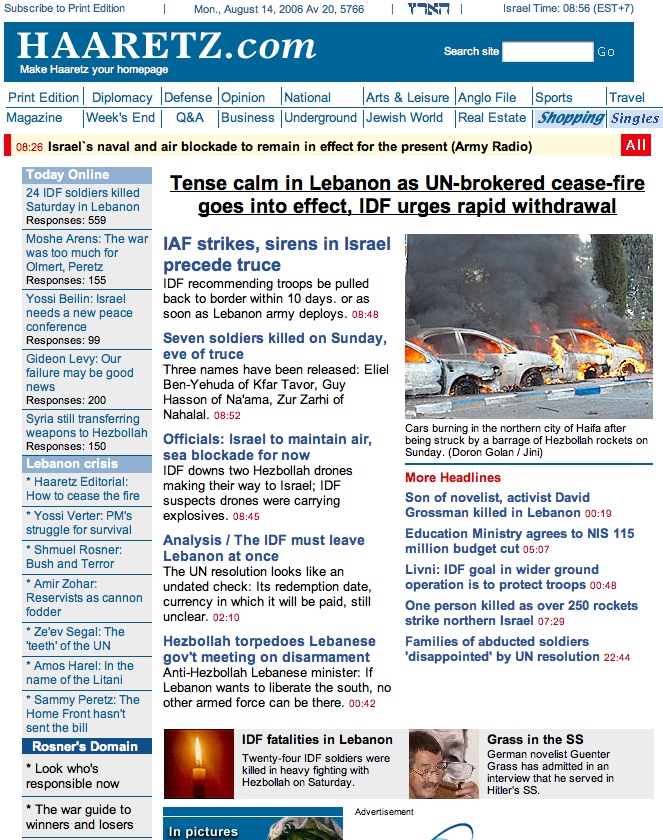
The clock just ran out. And now we find out that they were winding it up weeks before Hezbollah captured the Israeli soldiers. The captures were just a pretext: Israel and the United States wanted to smack Hezbollah around to demonstrate how weak the Iranian proxy was, and also to prepare American military planners for an Iranian attack with a "demo" of bombing (Shiite) missiles, bunkers and tunnels.
Of course, the demo failed. Failed Big Time. Thousands of dead all around, an inhuman consequence of the war Israel launched with American backing, but it's quite possible that Hezbollah's performance in the war has blown all the Pentagon's Iran fantasies to smithereens. In Washington, Bush and Cheney planned to kill lots of Lebanese in order to weaken Hezbollah and prepare the Iran war. That alone should chill you for a while.
It should chill you almost as much as witnessing the complete failure of the Western military style's beloved "full spectrum dominance", which we pretty much just did. Strategy, intelligence, tactics, training, logistics: all were complete failures. The Bush Administration misread Lebanon in a way that Ariel Sharon never would have. Now Israel's vaunted military "posture" has been crushed, revealed to all the world as incapable of defeating a well-armed modern infantry playing defense.
Israel's weak, almost meaningless military performance was one of the 21st century's signature moments – and the cruel ideologies endorsing the carpet bombing of Lebanon – this is the face of the Neoconservative world to come, if we do nothing.
The sense that Israel's military power would create order in the Middle East, forcing the Arabs to accept a peace deal on Israel's dictated terms, was one of the major principles of the Neoconservative philosophy, and the Revisionist flavor of Zionism before it. In the 1920s, Vladimir Jabotnisky wrote in the Iron Wall that only force would or could bring the Arabs to moderation – and today the Neoconservatives refuse, in principle, to negotiate with Evil Ones. Their fantasy that Israel and America could create a new, hard hegemonic (imperial?) alliance over the Middle East, on a foundation of splintered ethnic groups and military force, would never work. (Partly because those pesky subjects of the alliance tend to unite when they get bombed). Today, a core element of the Neoconservative philosophy has just evaporated as the UN saves the day. Its gears are gone.
Part of the Bush administration's plan here, according to Hersh, was to set Lebanon's other minorities against Hezbollah by bombing the common infrastructure of the country. This appears to me a pretty good example of the Iron Wall intended to divide Arabs so they cut a nicer deal with Israel. And yet again, it failed because it's a stupid fucking idea that has ruined Israel's fortunes with illusory violence at every turn. Hersh:
The long-term Administration goal was to help set up a Sunni Arab coalition—including countries like Saudi Arabia, Jordan, and Egypt—that would join the United States and Europe to pressure the ruling Shiite mullahs in Iran. “But the thought behind that plan was that Israel would defeat Hezbollah, not lose to it,” the consultant with close ties to Israel said.
Maybe Ariel Sharon learned this one the hard way in Beirut. He never wanted to try for the Litani River again, I think we can guess.
The information operation to justify the war was cynical and employed a "family == nation" metaphor designed to help the American audience psychologically project support for the war agenda, in a way that the ordinary spats between Israel and Arabs don't. The Israeli soldiers captured were just the 'morality' window dressing of the war makers. They were nothing but symbolic pawns, deliberately used to inspire the Israeli and American populations to support their leaders. They were just an opening bracket, a façade fronting a sinister "demonstration war" blasted through Lebanon, intended to enhance Israel and America's strategic might – and the Republican Party's dark political prospects in November.
Sy Hersh is giving us the goods again. He will probably be the one man who holds back the Iran war from happening. What he reports here is the hardest version of what I suspected: in DC they egged this war on, they planned it, they wanted to blow the shit out of Lebanon, and then Iran. They've wanted to run the Clean Break program since 1996. It is clear today that it's a failure at every level, but soon they'll hand out medals to make themselves feel better.
You need to read this whole article right away. This is another disastrous execution of an ideology that has critically damaged Israel, the United States, Lebanon and Iraq. The big winners are Al Qaeda and Iran. Tell me again why it's such a fucking good idea.
WATCHING LEBANON: Washington’s interests in Israel’s war.
by SEYMOUR M. HERSH
Issue of 2006-08-21, Posted 2006-08-14
In the days after Hezbollah crossed from Lebanon into Israel, on July 12th, to kidnap two soldiers, triggering an Israeli air attack on Lebanon and a full-scale war, the Bush Administration seemed strangely passive. “It’s a moment of clarification,” President George W. Bush said at the G-8 summit, in St. Petersburg, on July 16th. “It’s now become clear why we don’t have peace in the Middle East.” He described the relationship between Hezbollah and its supporters in Iran and Syria as one of the “root causes of instability,” and subsequently said that it was up to those countries to end the crisis. Two days later, despite calls from several governments for the United States to take the lead in negotiations to end the fighting, Secretary of State Condoleezza Rice said that a ceasefire should be put off until “the conditions are conducive.”
The Bush Administration, however, was closely involved in the planning of Israel’s retaliatory attacks. President Bush and Vice-President Dick Cheney were convinced, current and former intelligence and diplomatic officials told me, that a successful Israeli Air Force bombing campaign against Hezbollah’s heavily fortified underground-missile and command-and-control complexes in Lebanon could ease Israel’s security concerns and also serve as a prelude to a potential American preëmptive attack to destroy Iran’s nuclear installations, some of which are also buried deep underground.
[snip.........]
The U.S. government consultant with close ties to Israel told me, however, that, from Israel’s perspective, the decision to take strong action had become inevitable weeks earlier [than the kidnapping], after the Israeli Army’s signals intelligence group, known as Unit 8200, picked up bellicose intercepts in late spring and early summer, involving Hamas, Hezbollah, and Khaled Meshal, the Hamas leader now living in Damascus.
One intercept was of a meeting in late May of the Hamas political and military leadership, with Meshal participating by telephone. “Hamas believed the call from Damascus was scrambled, but Israel had broken the code,” the consultant said. For almost a year before its victory in the Palestinian elections in January, Hamas had curtailed its terrorist activities. In the late May intercepted conversation, the consultant told me, the Hamas leadership said that “they got no benefit from it, and were losing standing among the Palestinian population.” The conclusion, he said, was “ ‘Let’s go back into the terror business and then try and wrestle concessions from the Israeli government.’ ” The consultant told me that the U.S. and Israel agreed that if the Hamas leadership did so, and if Nasrallah backed them up, there should be “a full-scale response.” In the next several weeks, when Hamas began digging the tunnel into Israel, the consultant said, Unit 8200 “picked up signals intelligence involving Hamas, Syria, and Hezbollah, saying, in essence, that they wanted Hezbollah to ‘warm up’ the north.” In one intercept, the consultant said, Nasrallah referred to Olmert and Defense Minister Amir Peretz “as seeming to be weak,” in comparison with the former Prime Ministers Ariel Sharon and Ehud Barak, who had extensive military experience, and said “he thought Israel would respond in a small-scale, local way, as they had in the past.”
Earlier this summer, before the Hezbollah kidnappings, the U.S. government consultant said, several Israeli officials visited Washington, separately, “to get a green light for the bombing operation and to find out how much the United States would bear.” The consultant added, “Israel began with Cheney. It wanted to be sure that it had his support and the support of his office and the Middle East desk of the National Security Council.” After that, “persuading Bush was never a problem, and Condi Rice was on board,” the consultant said.
The initial plan, as outlined by the Israelis, called for a major bombing campaign in response to the next Hezbollah provocation, according to the Middle East expert with knowledge of U.S. and Israeli thinking. Israel believed that, by targeting Lebanon’s infrastructure, including highways, fuel depots, and even the civilian runways at the main Beirut airport, it could persuade Lebanon’s large Christian and Sunni populations to turn against Hezbollah, according to the former senior intelligence official. The airport, highways, and bridges, among other things, have been hit in the bombing campaign. The Israeli Air Force had flown almost nine thousand missions as of last week. (David Siegel, the Israeli spokesman, said that Israel had targeted only sites connected to Hezbollah; the bombing of bridges and roads was meant to prevent the transport of weapons.)
The Israeli plan, according to the former senior intelligence official, was “the mirror image of what the United States has been planning for Iran.” (The initial U.S. Air Force proposals for an air attack to destroy Iran’s nuclear capacity, which included the option of intense bombing of civilian infrastructure targets inside Iran, have been resisted by the top leadership of the Army, the Navy, and the Marine Corps, according to current and former officials. They argue that the Air Force plan will not work and will inevitably lead, as in the Israeli war with Hezbollah, to the insertion of troops on the ground.)
[.......]In the early discussions with American officials, I was told by the Middle East expert and the government consultant, the Israelis repeatedly pointed to the war in Kosovo as an example of what Israel would try to achieve. The NATO forces commanded by U.S. Army General Wesley Clark methodically bombed and strafed not only military targets but tunnels, bridges, and roads, in Kosovo and elsewhere in Serbia, for seventy-eight days before forcing Serbian forces to withdraw from Kosovo. “Israel studied the Kosovo war as its role model,” the government consultant said. “The Israelis told Condi Rice, ‘You did it in about seventy days, but we need half of that—thirty-five days.’ ”
.....Get ready for the New October Surprise. Michael Ledeen is pissed right now. He's gonna pull some shit to stage an Iran conflict, as James Bamford warned you in Rolling Stone.

Who, me?
It's just another disaster for the Jews and the Arabs, and certainly a disaster for America. When will these folks realize that their leaders are the real enemies, paralyzing their nations with fear to secure their own power?
And what about War Crimes charges? Billions of people want to know...
If the Israelis don't get the hell out of Lebanon, soon, then Hezbollah's "real war" starts. And Robert Fisk, at least, expects that it probably will. On the other hand, Haaretz is saying that the IDF wants to get out "within 10" days. So consider this the worst-case scenario, but this comes from one of the most experienced and battle-hardened journalists of the Middle East.
Robert Fisk: As the 6am ceasefire takes effect... the real war begins
Published: 14 August 2006
The real war in Lebanon begins today. The world may believe - and Israel may believe - that the UN ceasefire due to come into effect at 6am today will mark the beginning of the end of the latest dirty war in Lebanon after up to 1,000 Lebanese civilians and more than 30 Israeli civilians have been killed. But the reality is quite different and will suffer no such self-delusion: the Israeli army, reeling under the Hizbollah's onslaught of the past 24 hours, is now facing the harshest guerrilla war in its history. And it is a war they may well lose.
In all, at least 39 - possibly 43 - Israeli soldiers have been killed in the past day as Hizbollah guerrillas, still launching missiles into Israel itself, have fought back against Israel's massive land invasion into Lebanon.
Israeli military authorities talked of "cleaning" and "mopping up" operations by their soldiers south of the Litani river but, to the Lebanese, it seems as if it is the Hizbollah that have been doing the "mopping up". By last night, the Israelis had not even been able to reach the dead crew of a helicopter - shot down on Saturday night - which crashed into a Lebanese valley.
Officially, Israel has now accepted the UN ceasefire that calls for an end to all Israeli offensive military operations and Hizbollah attacks, and the Hizbollah have stated that they will abide by the ceasefire - providing no Israeli troops remain inside Lebanon. But 10,000 Israeli soldiers - the Israelis even suggest 30,000, although no one in Beirut takes that seriously - have now entered the country and every one of them is a Hizbollah target.
From this morning, Hizbollah's operations will be directed solely against the invasion force. And the Israelis cannot afford to lose 40 men a day. Unable to shoot down the Israeli F-16 aircraft that have laid waste to much of Lebanon, the Hizbollah have, for years, prayed and longed and waited for the moment when they could attack the Israeli army on the ground.
Now they are set to put their long-planned campaign into operation. Thousands of their members remain alive and armed in the ruined hill villages of southern Lebanon for just this moment and, only hours after their leader, Sayed Hassan Nasrallah, warned Israel on Saturday that his men were waiting for them on the banks of the Litani river, the Hizbollah sprang their trap, killing more than 20 Israeli soldiers in less than three hours.
Israel itself, according to reports from Washington and New York, had long planned its current campaign against Lebanon - provoked by Hizbollah's crossing of the Israeli frontier, its killing of three soldiers and seizure of two others on 12 July - but the Israelis appear to have taken no account of the guerrilla army's most obvious operational plan: that if they could endure days of air attacks, they would eventually force Israel's army to re-enter Lebanon on the ground and fight them on equal terms.
Hizbollah's laser-guided missiles - Iranian-made, just as most Israeli arms are US-made - appear to have caused havoc among Israeli troops on Saturday, and their downing of an Israeli helicopter was without precedent in their long war against Israel.
In theory, aid convoys will be able to move south today to the thousands of Lebanese Shia trapped in their villages but no one knows whether the Hizbollah will wait for several days - they, like the Israelis, are physically tired - to allow that help to reach the crushed towns.
Atrocities continue across Lebanon, the most recent being the attack on a convoy of cars carrying 600 Christian families from the southern town of Marjayoun. Led by soldiers of the Lebanese army, they trailed north on Saturday up the Bekaa valley only to be assaulted by Israeli aircraft. At least seven were killed, including the wife of the mayor, a Christian woman who was decapitated by a missile that hit her car.
In west Beirut yesterday, the Israeli air force destroyed eight apartment blocks in which six families were living. Twelve civilians were killed in southern Lebanon, including a mother, her children and their housemaid.
An Israeli was killed by Hizballoh's continued Katyusha fire across the border. The guerrilla army - "terrorists" to the Israelis and Americans but increasingly heroes across the Muslim world - have many dead to avenge, although their leadership seems less interested in exacting an eye for an eye and far more eager to strike at Israel's army.
At this fatal juncture in Middle East history - and no one should underestimate this moment's importance in the region - the Israeli army appears as impotent to protect its country as the Hizbollah clearly is to protect Lebanon.
But if the ceasefire collapses, as seems certain, neither the Israelis nor the Americans appear to have any plans to escape the consequences. The US saw this war as an opportunity to humble Hizbollah's Iranian and Syrian sponsors but already it seems as if the tables have been turned. The Israeli military appears to be efficient at destroying bridges, power stations, gas stations and apartment blocks - but signally inefficient in crushing the "terrorist" army they swore to liquidate.
"The Lebanese government is our address for every problem or violation of the [ceasefire] agreement," Israel's Prime Minister, Ehud Olmert, said yesterday, as if realising the truce would not hold.
And that, of course, provides yet another excuse for Israel to attack the civilian infrastructure of Lebanon.
Far more worrying, however, are the vague terms of the UN Security Council's resolution on the multinational force supposed to occupy land between the Israeli border and the Litani river.
For if the Israelis and the Hizbollah are at war across the south over the coming weeks, what country will dare send its troops into the jungle that southern Lebanon will have become?
Tragically, and fatally for all involved, the real Lebanon war does indeed begin today.
Be sure to look at LebanonUnderSeige.gov.lb. Recently posted was a piece by Azmi Bishara, an Israeli Arab and MK. This is one of the harshest things I have read in a while, but there is something very disturbing about how they use all this aircraft – and the distinct lack of morality to the whole thing... Bombs from planes are MoralityPlusGoodBoeingYay!!!
For news today keep an eye on Antiwar.com - and please give them some money, the world needs their work pretty bad. Also Haaretz in Israel and Lebanon's Daily Star. Agonist.org and Juancole.com are also good to check.
Also check out Uri Averny's "Lust for war".


When the skies rain death
13/08/2006 12:39:00
Azmi Bishara (Arab Israeli Member of the Israeli Knesset, Native of Nazareth)
The culture of the fighter plane is the culture of annihilation. The fighter plane is the quintessence of modern civilisation, the modern goddess. It is the product of the collective input of all the sciences and the neutralisation of all morals and values. In it converge the laser, micro-optics, microelectronics and high-tech aerodynamics, allowing for precision flying, hairline fine guidance, dead-on targeting and surgical destruction. It is hygienic and ultra-precise and its factories, hangars and assembly plants are as tall and spacious cathedrals. These planes are only manufactured in the most industrially developed states, assembled by huge corporations whose employees inhabit equality-oriented societies and receive high salaries. They can only be piloted by highly qualified individuals. They are simultaneously the product of absolute individualism and institutionalised collective labour. The employees who contribute to their manufacture embody societies that have achieved much; they are the elite, a cut above the rest, the chosen ones, the new Aryan race.
As with any goddess of consumerist society it has a built-in obsolescence; a new plane has to be produced every two or three years in order to keep up with demand, incorporating the latest technological developments and scientific discoveries in order to preserve her superiority over the gods of other people. The fighter plane makes the immoral moral. It soars above good and evil, a celestial goddess with an insatiable thirst for sacrificial tribute. The pilot does not see the blood; he doesn't see the bayonet or the bullet piercing through the body of the victim. He does not get dirty because he does not have to crawl. Or see the eyes of his victims.
Nor does he break the commandment thou shalt not kill. All he does is press a button from a long way away. All the victims hear is the screech of the oncoming missile. Then the world shakes around them and they topple over, without so much as swaying. Perhaps they feel excruciating pain before passing into nothingness. All people are helpless before the fighter planes; no father or mother can protect their child. Children are torn to pieces, or buried beneath the rubble of buildings that collapse with an echoing groan that blends with the sound of limbs being torn. Stones, planks of wood, shreds of steel crash into human bone and pulverise skulls -- all in the twinkling of an eye.
Meanwhile, from up there in the pilot's seat, all that can be seen are a plume of smoke and a cloud of dust. "Mission accomplished," radios the pilot to the base, as he executes a neat turn overhead in skies beyond the sea of morals. Then he lands, jumps out of the plane and heads to the barracks, helmet tucked under his arm like a motorcyclist. He goes for coffee in the cafeteria, exchanges jokes with his fellow pilots, with the female staff on the base, and with the mechanics who will be getting his plane ready for another sortie of death. Then he heads home. On his way he listens to some music, clowns around with some children and, maybe, engages in a conversation about politics. He might be earnest, or indifferent or incensed. He could be a leftist or a rightist, in support of gay rights or against them, a self- acclaimed dove or a rabid hawk. But these are not the criteria that qualified him to push the button. All such thoughts and criteria fade into meaninglessness in the religion of the fighter bomber.
The peoples of the world are divided into the haves and have-nots of F-15s and F-16s. The haves are divided into countries that own these planes and countries that are possessed by them. The Arabs are divided not only into the have-nots, but those who don't have and yet have made the planes into golden cows.These fighter planes are omnipresent. They can be visible or invisible. But there is no escaping their venom, nowhere to hide from their missiles. The planes remain in the air but their missiles will swoop down on the passengers of a fleeing car, a bus, an ambulance, and they will bore through the ceilings of bunkers and shelters until they reach the tender bodies within. Human flesh stands no chance against a missile flying toward it from a fighter plane. The body stands naked before the goddess who roams the heavens as edifices of stone and reinforced cement crumble before her. The planes wreak massive destruction, but they cannot resolve the battle against those who have right on their side. To do that the goddess's followers have to fight a ground war. But once the inhabitants of that civilisation start fighting on the ground, they start to die and begin to cry. This phenomenon has given rise to a curious belief, which is that while their soldiers have the right to kill, others do not have the right to kill their soldiers, even in war. This is why when one of their soldiers is struck they are overcome by shock and why when their armies suffer a defeat at the hands of the forces of the weak and oppressed they take it as an affront to the prestige of their army and their military superiority. At such a point Israel stealthily withdraws the ground forces and unleashes the F-16s to bomb "terrorist" locations, be they homes or villages.
It is a cowardly and vindictive way to behave, open to those who possess an air force which enable them to become arrogant airborne tyrants. On the ground they are human beings like everyone else: fragile and brittle. But in the air, with the protection of their goddess, they can stomp around, invisible to the naked eye but certain to make their thunder heard as they pass overhead, taking full advantage of the fragility of those who are left on the ground without planes, and even those who have taken refuge in the holes in the ground. They avenge themselves not just because they have the will to do so -- they hold no monopoly on will -- but because their goddess makes it possible for them to do so.
And the Lord said unto Joshua: "See, I have given into thine hand Jericho, and the king thereof, and the mighty men of valour.
"And ye shall compass the city, all ye men of war, and go round about the city once. Thus shalt thou do six days.
"And seven priests shall bear before the ark seven trumpets of rams' horns. And the seventh day ye shall compass the city seven times, and the priests shall blow with the trumpets...
" ...[A]nd it came to pass, when the people heard the sound of the trumpet, and the people shouted with a great shout, that the wall fell down flat, so that the people went up into the city, every man straight before him, and they took the city.
And they utterly destroyed all that was in the city, both man and woman, young and old, and ox, and sheep, and ass, with the edge of the sword...
And they burnt the city with fire, and all that was therein.
Only the silver, and the gold, and the vessels of brass and of iron, they put into the treasury of the house of the Lord.
And Joshua saved Rahab the harlot alive, and her father's household, and she dwelleth in Israel even unto this day; because she hid the messengers, which Joshua sent to spy out Jericho.
(Joshua 6)
It is destructive power that fills them with pride... the sort that comes before the fall. The death of a child, two children, three; the death of a woman or two; the destruction of an ambulance – when does brute force against innocent people become unacceptable? Thirty children? Fifty? In front of the cameras? How many when there are no cameras at hand? At what point do the scales tip? Cameras, incidentally, do not transmit the putrid odor of bodies crushed beneath the rubble.
It is difficult to pinpoint exactly when the cup slips out of the hand of an Arab or western official as he stares at the television screen. Which image of dying children got through to him? Did his mouth drop agape as his cup crashed to the floor? Did he choke on the food he was eating? Does he think that he should have listened to his aides sooner and called for an immediate ceasefire? Does he groan at the horror of the crimes committed by Israel or slump in despair at Israel's folly in forfeiting yet another opportunity?
Israel was built on targeting civilians. In 1948 it targeted them in order to displace them and usurp their land. It targeted entire villages that it alleged were fedayeen -- resistance fighter -- bases. The "strategy" was founded upon two tenets: the need to deter civilians from supporting the resistance, which is to say to repress the expression of any political or social position, and the need to feed and quench the Israeli thirst for revenge. This two- pronged military creed was epitomised by Unit 101, led by Ariel Sharon in the early 1950s. It raided villages, blew up houses and slaughtered the residents. Among the most notorious fruits of this philosophy were the massacres of Qubya,Nahalin and Al-Bureij in the fifties, and the massacres of Jabalya, Beit Hanoun, Al-Shajaiya, Qasba in Nablus and Jenin in more recent times. To perform these deeds Israel needed butchers, though it called them "legendary warriors". It was a hands-on approach. It did not involve F-16s. With these all that are needed are spoiled youths of the appropriate religious affiliation and with their hearts set on an American consumerist lifestyle.
Israel is deliberately targeting civilians in Lebanon, capitalising on an expedient moment. Its aims are to punish anyone who might have supported the resistance, to displace civilians northward in order to aggravate sectarian tensions in the country and to quench its barbaric thirst for revenge. The current attack, in all its ferocity and with its toll of innocent victims, was planned well in advance, with malice aforethought. Israel is a terrorist state. The diabolical logic of this state is actively supported by another terrorist state led by George Bush, a very dangerous, pathologically violent and sadistic man surrounded by a gang of cool and calculating Machiavellians and apologists for state terrorism. They ardently believe that civilians who don't own fighter planes are so far down the rungs of the ladder in the survival of the fittest that if they die well that's their own fault, a result of their own lack of realism.
This logic has one flaw that makes it unpardonable, a curse that will haunt that civilization, a permanent indictment of its control of the skies: how can children be expected to be "realistic"? How can anyone blame them for their own death?
It is wrong to sing the praises of dead children as if they were heroes, a disgrace to put their bodies on display. These children were not warriors. They were not in the resistance. They did not die in order to achieve a victory for others who didn't die and who hadn't put their lives on the line. These children died because they couldn't escape in time or manage to hide from the planes. They are the victims of the criminally barbaric civilization of fighter planes. Their murderers must be brought to account and the resistance against the aggression must be sustained.
The test of the Zionist left. By Yossi Beilin (Haaretz)
There are those who expect the Zionist left to join in the revelry of war, in the pathetic slogans such as "We will win" and in the fiery comments such as "Nasrallah will remember who Amir Peretz is."
There are those who expect us to join the non-Zionist left, which is calling for a unilateral cease-fire, accuses Israel of war crimes, demands that Hamas and Hezbollah be given what they want, and opposes all use of force. Both sides say this is the test of the Zionist left - and they are right.
We have a deep belief in the right of the Jewish people to a democratic and secure state, which has a stable Jewish majority: the state of the Jewish people and all of its citizens. We are convinced our national interest is in completing the moves toward peace with the Palestinians, Syria and Lebanon, and that there is no alternative to an agreement.
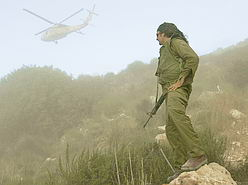 I am not gonna feel like writing tomorrow, so it's either now or the weekend. Here are a lot of bits from the past couple weeks in the Lebanon-Israel conflict. The window after the first two weeks was Israel's chance to capture the initiative against Hezbollah and attempt to achieve their hazily articulated goals in this vicious little war. It's a big war, but the space is very small.
I am not gonna feel like writing tomorrow, so it's either now or the weekend. Here are a lot of bits from the past couple weeks in the Lebanon-Israel conflict. The window after the first two weeks was Israel's chance to capture the initiative against Hezbollah and attempt to achieve their hazily articulated goals in this vicious little war. It's a big war, but the space is very small.
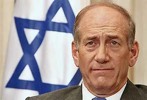 Escalations for the weekend: Haaretz: Security cabinet okays decision to expand ground operation in Lebanon:
Escalations for the weekend: Haaretz: Security cabinet okays decision to expand ground operation in Lebanon:
.......PM wavered on expansion decision
Olmert was hesitant prior to the meeting on whether to approve the proposed expansion of the IDF ground operation in south Lebanon.
Olmert was concerned that the plan presented by the defense establishment would result in hundreds of casualties, and therefore, wanted to subject it to a careful cost-benefit analysis. In Tuesday's fighting in Lebanon five soldiers were killed and 23 others wounded, two of them seriously. According to a government source, Olmert had also asked the army to present him with several different options for a ground operation.
A decision to send troops deeper into Lebanon is fraught with considerable risk. In doing so, Israel could set itself up for new criticism that it is sabotaging diplomatic efforts. Also, a wider ground offensive might do little to stop Hezbollah rocket fire on Israel, while sharply increasing the number of casualties among Israeli troops.
While most of the cabinet was expected earlier to back whatever Olmert decides, sources in the Prime Minister's Office said that three to four ministers were likely to oppose a large-scale ground operation regardless of Olmert's position. The IDF's proposal was for a two-week ground operation that would involve conquering the entire area south of the Litani River, and even a few areas north of it, in order to reduce Hezbollah's short-range rocket launching capabilities.
IDF Chief of Staff Dan Halutz said Tuesday that such an operation was necessary "in order to end this war differently." People who participated in discussions of the plan with him said they had never heard him speak as forcefully in favor of anything as he did in favor of the proposed ground operation. Peretz fully supports the army's plan, which he considers essential for Israel to achieve its diplomatic goals.
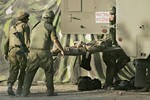 Nine paratroopers killed in attack on home in Dibel; 15 soldiers killed Wednesday in south Lebanon
Nine paratroopers killed in attack on home in Dibel; 15 soldiers killed Wednesday in south Lebanon
By Amos Harel and Eli Ashkenazi, Haaretz Correspondents, and Agencies Last update - 01:59 10/08/2006
Fifteen Israel Defense Forces troops were killed on Wednesday, the IDF announced late Wednesday night, as fierce fighting with Hezbollah guerillas raged in the southern Lebanon villages of Ayta al-Shaab and Debel.
The 15 IDF soldiers were killed in a series of firefights across the front. In the most serious incident, nine reserve paratroopers were killed and 11 wounded by antitank missiles fired on a house in the village of Debel, in the central sector. Four reservists from an armored brigade were killed in a tank explosion, apparently caused by antitank missiles, in the town of Ayta al-Shaab. An infantryman was killed late Wednesday when he was hit by a mortar in Marjayoun.
DEBKAFile: Israeli official spokesman say deep ground push into Lebanon approved Wednesday to reduce rocket attacks is put on hold for 48 hours to give more time for diplomacy August 10, 2006, 9:26 AM (GMT+02:00)
DEBKAfile adds: On the ground, the first troop and tank elements of the advance began moving Wednesday overnight and are continuing Thursday, Aug. 10.
The decision Wednesday, Aug. 9, by 9 votes, none against and 3 abstentions, includes areas up to the Nabatea plateau and Arnoun beyond the Litani River. The objectof the extension is to reach and eliminate Hizballah's rocket-launch centers. It deepens Israel's thrust to some 45 km from the border and calls for a further large influx of army reserves.
DEBKAfile’s military sources add the extended operation does not promise the total stoppage of all rocket fire against Israel, but could potentially bring about a sizeable reduction from up to 200 a day to some 30 or 50.
Also: The stakes of the Lebanon War have shot up with the expansion of the Israeli offensive up to the Litani and Nasrallah’s rejection of diplomacy in favor of battle
Israel's military of old was specialized in quick, mechanized warfare. As they settled into the occupied territories, despite all the heavy weapons, the IDF reoriented itself to battling Palestinians, typically armed with rifles, handguns or machine guns. The Palestinians have some rocket-propelled grenades, as well, but they lack advanced infantry weapons. So the IDF has phased away from preparing for war with real infantries, and instead play supercop on the hapless residents of the West Bank.
They really thought that Hezbollah was only as "thick" as HAMAS, I guess. The Israelis went storming in without realizing that Hezbollah had lots of anti-tank missiles - on rocky terrain that doesn't give a lot of space for tanks. The IDF doctrine failed in the face of a new kind of conflict.
Right now we are watching a turning point in the nature of warfare. Everything from pack mules to to hacking to encrypted satellite feeds fits into fourth-generation warfare (pdf). Sub-state actors will basically be able to fight a top-notch modern army.
ANALYSIS: IDF still not in control of strip along Lebanon's border By Ze'ev Schiff, Haaretz Correspondent 08:57 10/08/2006
The large number and the location of the casualties that the Israel Defense Forces sustained Wednesday indicate that the army does not yet control the narrow strip along the border, although this stage of the ground operation was supposed to have been completed already.
The two battles also reveal a great deal about Hezbollah's method of fighting. They took place in two relatively small communities, Ayta al-Shab and Debel, close to the international border, on territory that until May 2000 was in Israel's Security Zone.
The ground operation, dubbed "Change of Direction 8," was intended to conquer this border strip. First it was to be a two- to three-kilometer strip. Then it was expanded to five to six kilometers, including numerous Lebanese villages and towns. The mission was to blow up all Hezbollah's outposts in this strip and drive its forces out.
What happened in Bint Jbail recurred in Ayta al-Shab. Although it seemed that the town had been conquered, it transpired again and again that there were still Hezbollah men in it. Once again, clashes and battles took place, and again, the IDF suffered dead and wounded. Although the army had conquered the town, Hezbollah men were hiding in underground bunkers well camouflaged from the outside. The bunkers had been stocked with large quantities of food, enough to last for weeks, and ammunition, including antitank missiles and, in several cases, short-range rockets.
The bunkers are connected to electricity and, according to one report, are air conditioned. When the fighting dies down, Hezbollah fighters emerge from the bunkers and set up ambushes for IDF soldiers and armored vehicles. That is why soldiers are hit repeatedly in the same places.
On several occasions, there have been difficulties evacuating wounded soldiers under fire. At times, Hezbollah fighters have fired rockets at Israel from areas close to the border that the IDF had supposedly conquered already. The means available to flush the guerrillas out of their underground shelters are not always employed.
Senior officers have suggested, inter alia, that the army bombard these towns heavily and even destroy them. But in any case, a decision has been made not to reenter them at this stage. The IDF could forge ahead, as it has done in the last two days in the Marjayoun area. But even after such an incursion, Hezbollah fighters who remain in the bunkers could continue launching rockets. In other words, they could fire toward Israel from behind the lines of IDF forces that have progressed deep into Lebanon. It is clear that the Hezbollah men who stayed behind are equipped with two-way radios and receive information from scouts hiding near the border. This explains the difficulties in managing the fighting in south Lebanon, which the IDF has not encountered before.
Even if Hezbollah "loses", the writing is on the wall. In the 21st century "the State" itself is weakening. Sub-national organizations like Hezbollah, with economic, military, political, social, educational, medical (and often spiritual) branches are displacing the State.
One should remember that the Middle East's artificial European-drawn boundaries have left many overlapping ethnic groups. The Pashtuns now at the core of the Taliban straddle Afghanistan/Pakistan. The Kurds are organized a bit like Hezbollah, and the ruthless pursuit of the Kurds' interests has rewarded them well since the US toppled Saddam. But they too are divided between parties that ruthlessly fight each other.
In Syria, only a few dozen miles east of Israel's bombing campaign lie many major Arab Sunni tribes like the Dulaimis, who especially live in cities along the river into Iraq, where their cousins' tribes live, sparring with Kurds and Shiites.
In this kind of region, everyday people are going to direct their primary loyalties towards sub-national groups that they believe represent their interests. By the early 1990s, Hezbollah, which the Iranians helped create by binding together different Lebanese Shiites, was seen as something of a successful model – social, political, military: robustly structured to resist political pressure, infiltration and military assaults from the Israelis and others.
Before Saddam fell, The Iranians used the Lebanese sub-state model inside Iraq, to lay the framework for the Shiite rise to power. Very quickly, SCIRI, Muqtada Sadr's people, and the Dawa Party all had organized cadres of armed guys, but more importantly, social services and methods for trying to restore any sense of law and order shattered with the US invasion. If the guys on the block with guns keep the thieves away, then they are pretty much your state, even if they don't report to Baghdad.
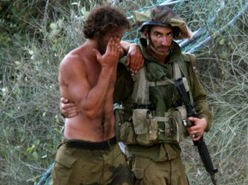 The news in Israel right now is that 15 reservists got killed in Lebanon, with heavy fighting around Bint Jbail, a site the IDF captured and subsequently evacuated. As the maps made clear, Bint Jbail is not more than a few kilometers from the border, yet the Israeli forces, despite all the bombing and everything, have not been able to hold that area, once they reached it and tried to occupy.
The news in Israel right now is that 15 reservists got killed in Lebanon, with heavy fighting around Bint Jbail, a site the IDF captured and subsequently evacuated. As the maps made clear, Bint Jbail is not more than a few kilometers from the border, yet the Israeli forces, despite all the bombing and everything, have not been able to hold that area, once they reached it and tried to occupy.
Reports in the Israeli media indicate that Hezbollah is able to keep attacking in areas the Israelis have already 'captured.' I think it's pretty likely that Hezbollah has drilled tunnels hundreds, if not thousands of meters long, attached to deeply hidden bunkers with all the necessary weapons and supplies. It is an amazing intelligence failure that the Israelis didn't anticipate this, and still, within a very small space the IDF has not been able to block out Hezbollah. The tempo of rocket attacks has not been curtailed in any serious way, and Israeli military analysts don't really think it can be shut down without a wide invasion. Hezbollah is winning the tactical situation by playing very hard-core defense with lots of anti-tank missiles. So far, it's mostly been a successful military strategy.
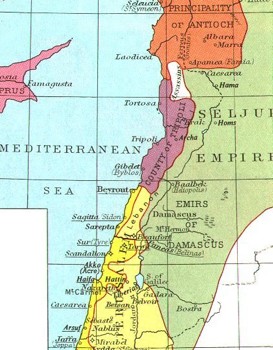 This is in keeping with the local style: in the good old days of the Seljuk Empire (c. 1100), the Hashshashin, or Assassins, would hang out somewhere between Damascus and Antioch - the home of the Holy Hand Grenade. The map's white spot shows a patch of mountainous land where the Assassins held sway. Mountainous redoubts are easier to defend, and such clever methods have migrated about 200 miles south, where nearly a millennia later, some pretty insane shit is going down.
This is in keeping with the local style: in the good old days of the Seljuk Empire (c. 1100), the Hashshashin, or Assassins, would hang out somewhere between Damascus and Antioch - the home of the Holy Hand Grenade. The map's white spot shows a patch of mountainous land where the Assassins held sway. Mountainous redoubts are easier to defend, and such clever methods have migrated about 200 miles south, where nearly a millennia later, some pretty insane shit is going down.
Well then, thats enough rambling background. Here's some damn links.
The rockets keep coming: Hizbollah rockets kill 15 in northern Israel. Hapless reservists. An ugly scene. IDF Raids near Tyre.
Emotional reaction in Israel propels poor policy:
`Peace' is a term not used in the public space in Israel anymore...No one expects any dialogue on a real practical level. The military always offers a shortsighted immediate way out. The wish to identify with the power of the gun and the uniform is still alive in Israeli tribal DNA. Revenge is a word not used in the open; it is there in the undercurrent of the emotions expressed by the public, our bombardment of Gaza had the same motive behind it.
UK Guardian: Israeli pilots 'deliberately miss' targets: Fliers admit aborting raids on civilian targets as concern grows over the reliability of intelligence
You need to give money to AntiWar.com. Their work is important and kinda spooky. Rumors that apocalyptic Christian writers are visiting the White House. Stratfor has free podcasts. Updates on the Tikkun Olam blog (תקון עולם: Make the World a Better Place).
Iranian dimensions:
Haaretz: Nasrallah's dilemma By Amos Harel and Avi Issacharoff
As the war progresses, the depth of Iranian involvement in Hezbollah activity is increasingly being revealed. Hezbollah has established a Tehran-sponsored forward outpost here, under the noses of the Israelis. When the war ends, Iranian soul-searching will include the question as to whether the activity here was not premature: whether the strategic card of the rocket battery was not revealed too early, for the sake of a negligible goal like the release of the four prisoners, instead of saving it for the day of judgment, for the eruption surrounding its nuclear program.
The Iranians are involved up to their necks in Hezbollah activity: Their advisers participated in the firing of the missiles at Israeli ships and in the firing of Strela (SA-7) antiaircraft missiles at Israeli planes and helicopters. During Israel Defense Forces operations in the south, sophisticated listening rooms were discovered, via which the Iranians eavesdropped on Israeli communications and telephone networks, both civilian and military.
Guardian: Bloody night in Beirut as Israel intensifies aerial bombardment: IDF warns UN troops will be attacked if they repair bridges (aug 8)
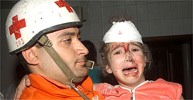 Information warfare sector: Olmert meets with spokespeople to sharpen PR message. PrisonPlanet says: Another Israeli Myth Exposed: There Were No Hezbollah Rockets In Qana but Israeli media alleges Qana killing was staged, dubbing this pattern Hezbollywood. With a certain sense of weird horror, Haaretz features "Where there's smoke, there's liars": "1. The Muslim Lie Mode, or The Dead as Visual Aid (When Arabs report what Israel has done) 2. The Israeli Lie Mode, or The Dead as Enemy Weapon (When Israelis report what Israel has done). 3. The American Lie Mode, or The Dead as Nonexistent." Anyway, Half of U.S. Still Believes Iraq Had WMD.
Information warfare sector: Olmert meets with spokespeople to sharpen PR message. PrisonPlanet says: Another Israeli Myth Exposed: There Were No Hezbollah Rockets In Qana but Israeli media alleges Qana killing was staged, dubbing this pattern Hezbollywood. With a certain sense of weird horror, Haaretz features "Where there's smoke, there's liars": "1. The Muslim Lie Mode, or The Dead as Visual Aid (When Arabs report what Israel has done) 2. The Israeli Lie Mode, or The Dead as Enemy Weapon (When Israelis report what Israel has done). 3. The American Lie Mode, or The Dead as Nonexistent." Anyway, Half of U.S. Still Believes Iraq Had WMD.
The US-Israeli link: this looks at Condi and an IDF spokesperson as two flipsides: Between two friends by Tom Segev:
During the past 39 years since the Six-Day War, the United States did not force Israel to pull out of the West Bank, but more than once acted to block Israeli military actions. Over time, we have grown accustomed to the Americans saving us, not only from the Arabs, but from ourselves too. Not in this war. It is still unclear whether this war was coordinated with the United States; only the release of government records of the past three weeks will shed light on this. Whatever the case may be, the impression is that the Americans are linking the events in Lebanon to their failing adventure in Iraq.
Israel's elites, in all fields, are made up of people who spent a number of years in the United States and returned with not only professional skills but also an appreciation for the value of the individual and basic freedoms. For the most part, this was a useful process, even though it did contribute to a fading of social compassion. This process of Americanization has led Israel in recent years to covet a role in what Bush has described as a war on the "axis of evil."
As such, Israel has adopted the moral values of Hezbollah: Whatever they are doing to the residents of northern Israel, we can also do to the citizens of Lebanon, and even more. Many Israelis tended to look at the Qana incident primarily as a media disaster and not as something that imposed on them any ethical responsibility. After all, the restrictions of humanitarian warfare are not applicable to the "axis of evil." Just like in Iraq, the lessons of Vietnam have been forgotten. It is hard to avoid the impression that the routine brutality of oppression in the Gaza Strip and the West Bank is also reflected in the unbearable ease with which Israel has forced out of their homes hundreds of thousands of Lebanese and bombed civilians.
Tense situation with Israel's own Arab population (20%): Border Police search Israeli Arab homes without warrants.
Loss of Momentum by Amir Oren (Haaretz):
The IDF's greatest loss was momentum. The first week of the campaign went reasonably well, borne on the wave of the stunning success of the attack of Hezbollah's long-range rockets. Between the middle of the second week and the middle of the third week the IDF lost a week, not least because of its reaction to the eight Golani Brigade soldiers who were killed in Bint Jbail. That lost week, as the rain of Katyusha rockets continued to fall from on high, undermined the army's self-confidence and thrust it into a posture of public self-defense. It shifted into recovery mode only because of the time it was granted by Washington. Fear of a large number of casualties was the major factor in the government's hesitations, for almost a week, about whether to send more divisions into the fray, entailing a call-up of reserve units.
The General Staff admitted the IDF did not work fast enough. They did not grasp the fact that the context had changed and that this was not just one day of battle or a routine-security incident, but a war, which has its own laws. Commanders who were used to operations in the territories did not internalize the need for speed, persistence and continuity.....
The sweeping criticism did an injustice to Division 91 and to the "hunt" concept in the air force. A colonel in the division said this week that for months the division's senior command "drove officers crazy with alerts to prevent abductions, turned over every stone and laid down new stones in order to turn them over, too." The abduction, the colonel noted, was comparable to a special operation by an IDF commando unit, which, in the absence of precise intelligence, is difficult to thwart even after all the preparations across the sector.
Various people yelling at each other: ADL: Hugo Chavez comparison of IDF and Hitler is Outrageous. Yesha (settler) Rabbinical Council objects to ridicule of Chief IDF Rabbi.
Hawks crow: Win that war! (Haaretz). Peace Index: July 2006 / Support for the war and the IDF holds up.
A final batch: I got nothing left after these Haaretz bits: ANALYSIS: There appears to be a command problem in the north. From war, an opportunity. Snatch a possible victory. Down but not out. Little Satan has big teeth. ANALYSIS: Deployment of Lebanese army may be good for both sides.
Well, that's all for a while. Enjoy.
Currently I am putting together a sweet Google Earth view of the south Lebanon tactical situation. In these images, various map overlays have been turned on and off. The first image shows bookmarks and tactical IDF troop maps from Stratfor. These locations are estimated and perhaps tainted with disinformation, but still probably roughly right.
The major overlay map is farther below. I lined all these up by eye, and made use of the transparency of PNG files to make nice translucent edges on the images. Israeli flags mark Lebanese villages (theoretically) occupied by Israeli forces. The blue boxes are notable Israeli units - their types are noted in the big image, which you can go get yourself from the Agonist's fine coverage.
You can download the complete Google Earth animation I put together so far at this link. It should drop right into your Google Earth Browser. Just run the folder as an animation (press play), and toggle the image overlays on and off for various views of the military situation.
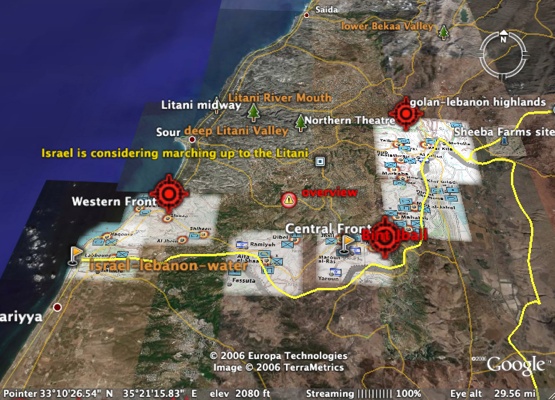
This is in the close quarters around the Kiryat Shmona (Qiryat Shmona), an Israeli city that has been heavily pounded with dozens of rockets every day.
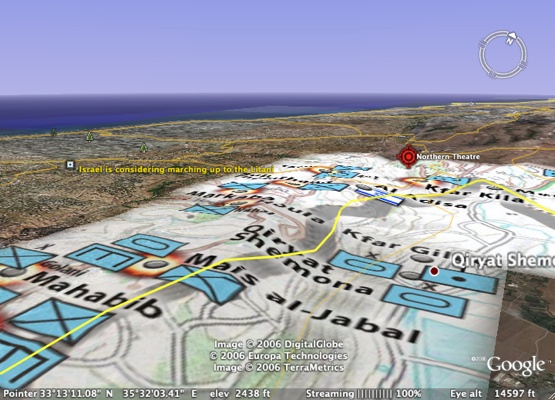
Here is (almost) the same view, just satellite, without tactical overlay:
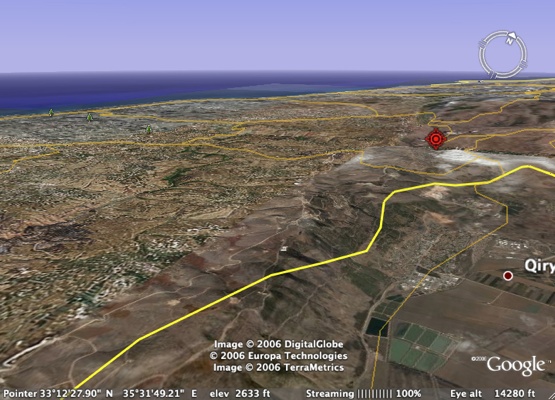
This shot faces back south. The white line here indicates the line to the Israeli border, about 11 miles. This is the upper part of the Litani River valley, a very deep feature running from the Bekaa Valley to the Mediterranean, well north of Tyre. The Israelis occupied up to the Litani River until they were defeated by Hezbollah and withdrew sans peace agreement in 2000.
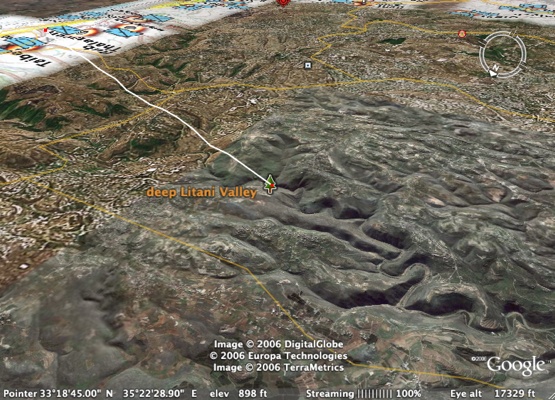
If we zoom back a bit farther, this image adds the original large Stratfor map, placed on top of the landscape - higher altitude, same angle. THe whole area up and to the right is where the Israelis would try to conquer and destroy Hezbollah. However, as we can see, Israel has had little luck getting securing the immediate few thousand meters of the Lebanese south border region - the line of explosions along the top here: (we are facing south-southeast)
If we flip it around, facing north from above northern Israel, look here. This is the big Stratfor master map, not the detailed tactical views noted above.
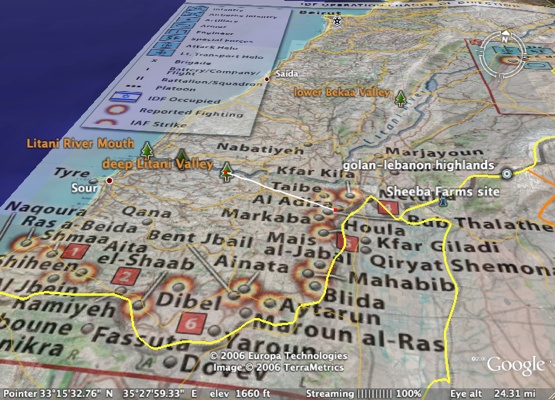
Well that is all for now. Oh wait no it isn't. From the bowels of eccentric retired Israeli hawks come a couple stories from DEBKAFile – a weird news source to be taken with grains of salt. Still, there is much of interest from Debka:
DEBKAfile’s military sources disclose: Hizballah’s rocket offensive against Israel is orchestrated from a rear command located in the Syrian town of Anjar
August 7, 2006, 12:41 PM (GMT+02:00)
While Israeli officials keep on insisting that Syria must be kept out of the conflict, the fact is that the Assad regime is already in it up to their ears – with a leading role in the Hizballah rocket attacks on northern Israel.
The command which coordinates the pace of those attacks is located at the Anjar base of the Syrian Army’s 10th Division opposite the Lebanese town of Az Zabdani. It is manned by Iranian and Hizballah officers, who take their orders from a Syrian military intelligence center in Damascus to which Iranian Revolutionary Guards intelligence officers are attached. It is headed by a general from one of Syria’s surface missile brigades. This joint command is provided with the most up-to-date intelligence and electronic data available to Syria on targets in Israel and IDF movements. The timing and tempo of Hizballah rocket strikes are set according to that information.
To keep the rockets coming without interruption, the joint Hizballah-Syrian-Iranian command is also responsible with keeping Hizballah supplied with an inflow of rockets and launchers. They use smuggling rings to slip the supplies into Lebanon by mule and donkey which ply the 5,000-7,000 feet mountain paths that straddle the Syrian-Lebanese frontier.
A senior Israeli officer told DEBKAfile: We can go on bombing Lebanon for many weeks, but that will not stop the rockets..
 Meanwhile Zarqawi-Mark-2 has arrived to save the day. This story smacks of some truth and a lot of hot air. But still interesting:
Meanwhile Zarqawi-Mark-2 has arrived to save the day. This story smacks of some truth and a lot of hot air. But still interesting:
Tehran Sends Archterrorist Mughniyeh to Rescue Hizballah
DEBKAfile’s Exclusive Military Report: August 5, 2006, 4:57 PM (GMT+02:00)
In the middle of the fourth week of the Lebanon War, the tide began to turn in Israel’s favor. DEBKAfile’s military sources report the battlefield finally responded to the effect of Israel’s air might, its tank columns, the pounding by mobile artillery and naval craft and its repeated armored infantry assaults.
After losing 44 fighting men, more than 30 civilians, many thousands of wounded and billions of dollars of damage, finally, the Israeli military was given the chance to do what it does best: focus its firepower instead of spreading it out thin over too many targets.
The setbacks of the first three weeks were partly due to tactical incompetence and laggard decision-making on the part of prime minister Ehud Olmert and defense minister Peretz. Israeli troops therefore spent too long in abrading combat against stubborn Hizballah resistance in such places as Maroun er Ras and Bint Jubeil. But as soon as Israeli ground forces shifted to the massive, long-distance firing mode which they knows best, the impact on the warfront was immediate. The battle went their way with a minimum of casualties. In places where Israeli troops adhered to the close combat tactics practiced in the first three weeks, they continued to suffer high casualties.
Hizballah soon showed signs of distress. Lacking the weapons and resources to stand up to IDF’s precise-shooting juggernaut, their commanders quickly pulled their men out most combat sectors of South Lebanon and ordered them to regroup in five places:
1. The Western Sector and the center of Tyre.
2. The Wadi Hajar pocket east of Tyre.
3. The Central Sector surrounding Bint Jubeil, where the outcome is still unresolved after many days of fighting.
4. The Wadi Saluki area northwest of the northernmost Israeli town of Metullah.
5. The Eastern Sector, including al Khiam, the Shabaa Farms and Mt Dov, which has seen little fighting - although last week Israeli forces began - then stopped - a major offensive before it got underway.
These pockets are now the main launching-pads for rockets fired into Israel. Outside, there is no ground fighting in South Lebanon but for Israeli air strikes.
Hizballah also has also been using the Tapuach and al-Haroub areas south and northeast of Sidon for shooting rockets. It is from this region that Hizballah fired the long-range Khaibar-1 missiles at Hadera Friday night, August 4, which came 45 km short of Tel Aviv. Saturday morning, Sidon’s 200,000 inhabitants and its outlying villages up to the Zahrani River were warned to leave their homes and head north to escape the coming Israeli air offensive.
Until the Khaibar attack on Hadera, the concentration of Hizballah’s rocket launchers and stores in and around Sidon had been immune from Israeli attack – largely because Olmert and his senior ministers refused to increase the number of ground troops deployed in Lebanon. The military commanders had to do their best with the limited numbers available.
In other words, with the right manpower level, Hizballah’s abilty to fire rockets can be dented, notwithstanding claims by Israel officials and generals that there is no way to do this when most of Hizballah’s 13,000-rocket stockpile remains intact.
But even cutting down on the daily 200-plus rocket blitz on northern Israel is not plain sailing because:
First, Neither the Israeli Air Force nor any other air force is capable of completely halting rocket fire from the ground. In the relatively small distances between Lebanon and Israel, the short-range Katyusha rockets have the effect of medium-range weapons, while the short-to-medium range rockets perform like long-range missiles.
Second, Israel does not have enough infantry on the ground to make substantial inroads on Hizballah’s rocket-firing capabilities.
Third, Iran and Syria are constantly restocking Hizballah’s diminishing supplies of rockets of all types, launchers and operating manpower by a round- the-clock airlift from Iran via Syrian military air fields. Some of the incoming supplies are destroyed by Israeli air attacks as they cross into Lebanon, but a substantial part is conveyed to Hizballah by smuggling networks employing mules to traverse Lebanese mountain paths. Even if 2,000 have been wiped out and a similar amount has been fired, no one knows how many are left in stock because it is replenished. As long as that corridor is not severed by bombing the Syrian stopover air facilities, Iran will continue to top up Hizballah’s stockpile. Therefore, the rocket offensive cannot be reduced by very much.
Fourth, Israeli forces do not operate in all parts of South Lebanon.
Hizballah’s withdrawal to five pockets in South Lebanon affords the IDF certain tactical advantages - although liabilities too.
The Advantages:
It is now possible to carve the region the Israeli army controls into three sections, western, central and eastern, a tactic familiar from the Gaza Strip, for encumbering Hizballah guerrilla movement between the sections. The goal is to confine Hizballah to the five pockets and place them under blockade. They can then be made to capitulate or face liquidation.
The Liabilities:
Leaving the two banks of the Litani River, the Nabatea plain and Hazbaya to the north of the river in Hizballah hands leaves a route open for its reinforcements to come through and to strike Israeli forces from the rear.
Nonetheless, by Thursday, August 3, Hizballah was showing signs of being in trouble.
A. Local Hizballah village commanders signaled repeated appeals for more manpower and ammunition. The appeals were not met because outside forces cannot break through the defense lines held by the advancing Israeli troops. The village commanders were therefore told by their superiors to fight to the last man and last bullet and reserve the last grenade for suicide.
B. Hizballah’s shadowy leader, the long-wanted Imad Mughniyeh, was hurriedly appointed commander of the southern front as a last resort to save South Lebanon from falling to Israel.(picture from the 1980s)
DEBKAfile’s military and counter-terror sources maintain that this appointment raises the conflict to a new and dangerous level on several counts.
Mughniyeh, wanted for a quarter of a century by the FBI for the huge bombing attacks he orchestrated on the US embassy in Beirut and American and French troops, as well as a spate of hijackings and murders, is important enough to take orders from no-one ranking lower than Iran’s supreme ruler, Ayatollah Ali Khamenei. Those orders come through the Revolutionary Guards commander Gen. Rahim Safavi.
Therefore, placing Mughniyeh at the head of Hizballah forces in South Lebanon confronts prime minister Olmert uncomfortably close to Iran’s supreme leader; ranges defense minister Peretz opposite his Iranian counterpart Mustafa Najer and chief of staff Lt. Gen Dan Halutz opposite Gen. Safavi, while on the warfront, Israel’s war leaders face the formidable Mughniyeh, Tehran’s secret weapon for rescuing Hizballah from collapse.
Informed circles in the West have a high opinion of Mughniyeh’s military, intelligence and tactical skills. His hand was seen in the transformation of al Qaeda’s 2001 defeat in Afghanistan into a launch pad for its anti-US campaign in Iraq and many other ventures in the terror war against America. After the death of Abu Musab al Zarqawi, Mughniyeh is rated the world Islamic terror movement’s most outstanding field commander.
Therefore, while the appointment is a measure of Israel’s belated military success in the Lebanese war, it also brings the conflict ever closer to two dangerous orbits – Tehran and al Qaeda. Mughniyeh is the only undercover agent in the Middle East who enjoys the complete personal trust of Khamenei and Osama bin Laden, on both of whom he is in a position to call for aid.
On the diplomatic front, even if the United States and France can get together on a unified UN Security Council ceasefire resolution, DEBKAfile’s military sources report that neither Iran nor Hizballah has any intention of complying with a resolution dictated by the United States, France and Israel.
Well at the very least, that last bit is exactly the message a bunch of neo-Likudniks would want to be saying, regardless of whether or not it's true. But it might be true. I think these guys are far too optimistic about Israel's situation.
Anyhow that's pretty much the lay of the land, so to speak.